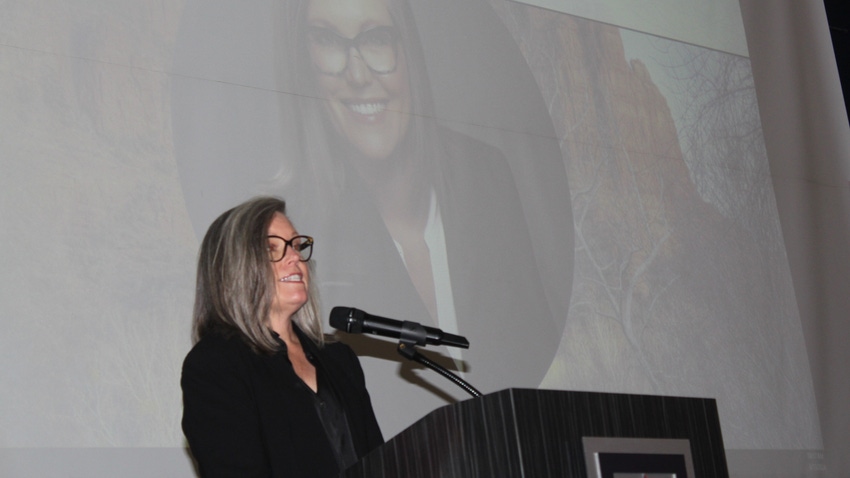
Water. You either have it or you don’t — and everybody needs it.
Emphasizing that “Water is the most critical issue of our time,” Water Resources Research Council Director Sharon Megdal opened two days of conference discussion. She was joined in her welcome by University of Arizona Vice President for the Agricultural Division, Shane Burgess, who added: “We are in the bullseye of climate change as it pertains to being the hottest and driest.”
Taking Arizona’s Governor [Katie Hobbs}, adding in one of her appointees [Agriculture Department Director Paul Brierley], mixing in the leader of the Arizona Farm Bureau [Stephanie Smallhouse], tossing in a few dozen other seasoned executive level movers-and-shakers — along with more than 700 attendees — and you’ve got a lot of trained/talented folks concerned about the water situation in the West.
“Rural Arizona has a groundwater problem with more water pumped each year than is annually replenished by nature,” the governor said on March 13. “We’re over-drafting our water bank account and once pumped, it won’t return in our lifetimes, so a day of water policy discussions is a day well spent. This is not the time for anyone to sit on the sidelines.”
In her keynote address, Hobbs was emphatic that the time for solutions is now. “We need to solve the rural groundwater issue this year because failure to act is not an option. We must tap into common ground to find answers that work and put aside petty politics to do so. Fortunately we are moving the ball forward on securing our state’s water future.”
Optimism, but few solutions
Statistics and proposed solutions were few in the governor’s address at the annual water conference, but optimism abounded. “A healthy Colorado River fuels our farms, our economy, and our way of life here in the West,” said Hobbs. “That’s why all water users need to share in the responsibility of finding solutions to the challenges we face. The Colorado River is too important to go without truly sustainable management.”
The Director of the Arizona Department of Water Resources, Tom Buschatzke, concurred, and as Chair of the Governor’s Water Policy Council added: “Water is one of Arizona’s most precious resources and efforts like this will build on our legacy of responsible water management.”
It’s of particular interest to someone who has spent a lifetime farming in California and Arizona, Hobbs’ appointed Director of Agriculture, Paul Brierley who grew up among fields of alfalfa, beets, and tomatoes. When he wasn’t bailing hay, he was a student of production agriculture, an effort that resulted in today’s leadership of the 300-person department.
“Water is at the top of our list of priorities,” he told his audience. “We’re vulnerable to climate change, so water and the sustainability of our groundwater are top concerns.”
Touting agriculture as a $23 billion industry in the state, he said: “Agriculture is the largest user of water and we know some feel farming in the desert wastes that water — but that couldn’t be further from the truth. We grow crops here BECAUSE of the desert, not IN SPITE OF the desert. If I had the whole Colorado River system in a bathtub and could apply it anywhere to produce food and fiber, I’d use it in Arizona.”
As an example, he cited statistics involving acre-foot of water used in the growing of crops in the Upper Basin of the Colorado (7.6 acre-foot to produce a thousand dollars of crop while in the Lower Basin it took only 1.2 acre-foot to produce the same value of crop — six times the economic productivity on desert land).
“Low water-use crops are great if they provide good yield and offer a good market and crops such as alfalfa actually stand up well when talking productivity or economic return relative to units of water used,” he said.
“As chair of the UA”s “Future of Agriculture & Food Production in a Drying Climate” commission, we (researchers and industry in partnership with farmers in their fields in real-world conditions) are studying how to keep agriculture productive in the face of a changing climate with less water and Arizona is THE Place to solve this problem.”
Dissention remains
There is still dissention and discussion on the best way to accomplish that goal. The governor has called the water crisis a priority issue and is working to modernize and secure the state’s water supply by better management of existing supplies, investing and upgrading infrastructure and providing leadership needed to bring all parties into the solution mix so that every stakeholder has a seat at the table.
Said the governor: “This bipartisan group representing agriculture, industry, cities, tribes, rural Arizona and others have started developing recommendations to address challenges faced in groundwater supplies. These plans were turned into legislation, but the bill was never even given a committee hearing. Instead we got another legislative bill that not only doesn’t give rural communities a voice in the solution, it would silence them instead. This is beyond acceptable and will not receive my signature.”
The debates and discussions continue toward finding a consensus decision on how to resolve water problems moving forward.
About the Author(s)
You May Also Like




